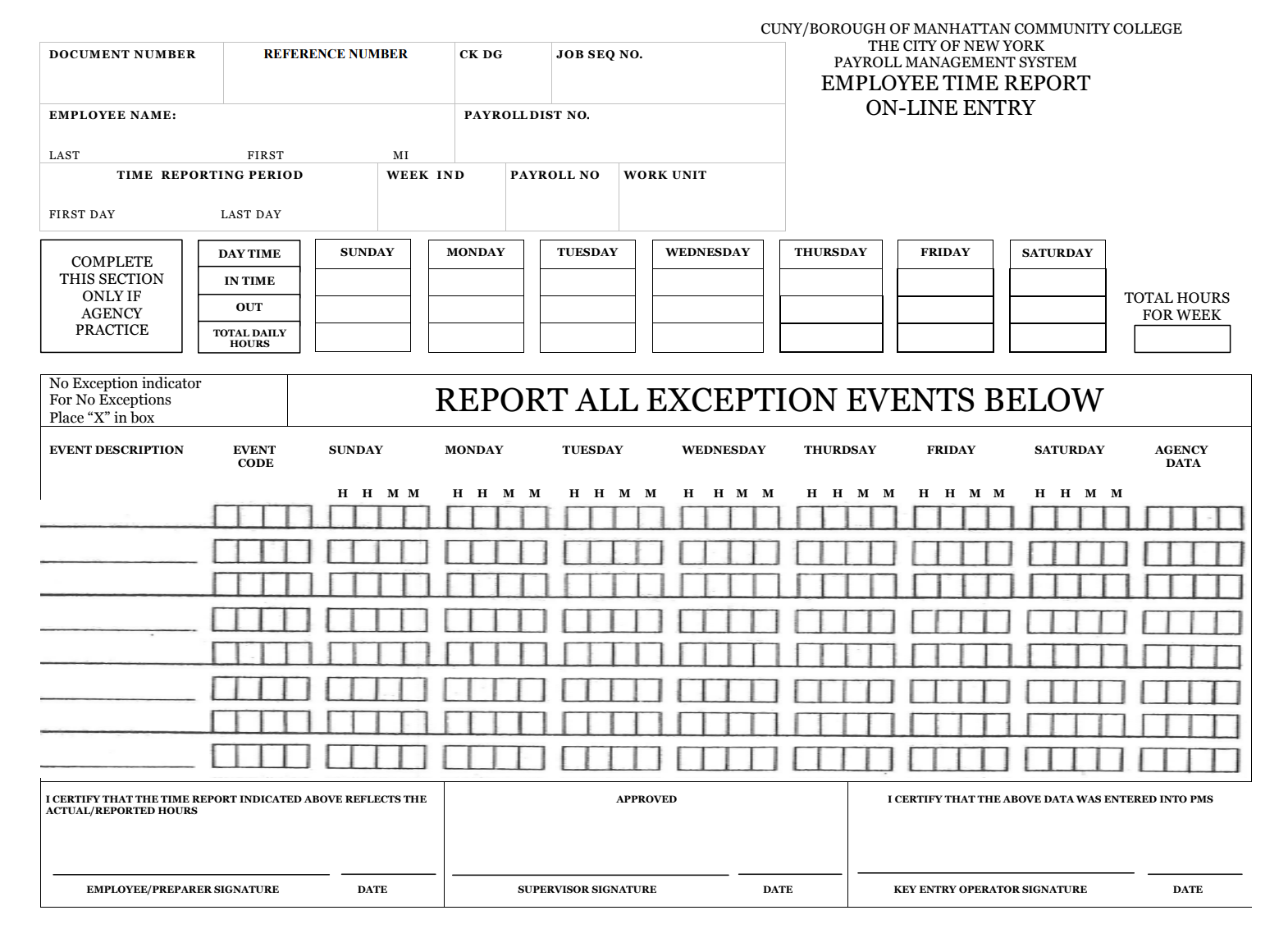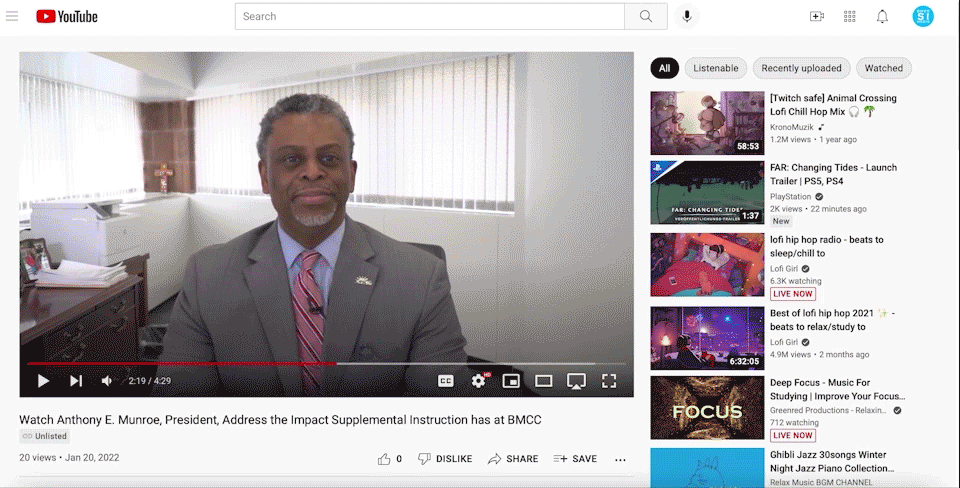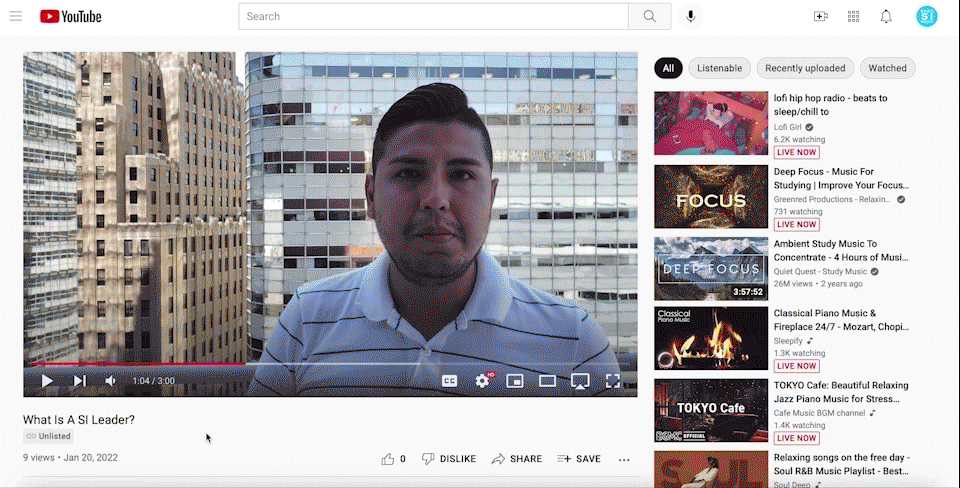
Discover the benefits of a SI Faculty and SI Leader partnership. One of the great advantages of the partnership is employing each other’s knowledge and experience to drive student success. SI Faculty understand that SI Leaders champion their peers by providing ground-level support and feedback to help achieve learning outcomes. Mutual respect is also key. Click here to view videos.

SI Faculty talk about their experiences working with SI Leaders. Hear from first-time participants to those more seasoned in the SI program. Get practical tips and working knowledge of how successful relationships between SI Faculty and SI Leaders are born and maintained. SI Faculty also share what teaching was like before and after partnering with a SI Leader. Click here to view videos.

At BMCC, the SI program was adopted in sections within select courses. The use of the program was monitored in these sections through observation and data gathering for a set time. The Office of Institutional Effectiveness & Analytics then published the outcomes of the trial in its report, Supplemental Instruction Outcomes, which shows the effectiveness of the SI program in these groups compared to groups without SI. Click here to read the IEA Report.

The Enrollment, Retention, and Completion Report is an annual report that tracks the progress of new and continuing students. The Office of Institutional Effectiveness and Analytics (IEA) is responsible for and provides support in ensuring the implementation of the College’s Institutional Effectiveness Plan, which provides BMCC with evidence of progress towards achievement of its mission and institutional goals. Click Here to read the IEA Report.

This interactive, participatory workshop’s focus is on learning in classrooms, starting by reflecting on faculty as learners, then as students as learners. We identify strategies to support learning for all members of the learning community, and experiment with different pedagogical approaches and reflect on our experience. Click for video.

This workshop examines the role of Supplemental Instruction in fostering the college mission to provide a community where everyone can thrive. Participants examine their syllabi, course materials, course assignments, and Supplemental Instruction sessions in and out of the classroom through the lens of advocacy and equity. Click for video.

This workshop examines how SI can be used in a course where the work ( in and out of class ) often focuses on collaborative creation and exploration. Participants learn techniques and strategies for engaging SI to enhance and support student collaboration, communication and group work in creative projects. Click here to view video.

Professor Johannes Familton from BMCC’s Math department, has been using Supplemental Instruction longer than any other professor at BMCC. He discusses which peer to peer learning model may be best for individual faculty depending on their particular class, and both what and how they are teaching. Click here to view video.

In a cross college SI Professional Development Day, Professor Ke demonstrates how he uses a series of online videos to help students in the Math Department learn from each other across a series of related courses. Click here to view video.

From the beginning, BMCC has called their approach to Supplemental, Instruction, 'SI-Influenced'. The home of SI, UMKC, is promoting the 'SI-Influenced' model and have complimented colleges who have made SI their own. Click here to view video.

Read a letter of support to the BMCC Supplemental Instruction community from Julie Collins, the former Executive Director of the International Center for SI (2011-2021) at the University of Missouri at Kansas City, where Julie was also the Director of Academic Support and Mentoring, and is herself a SI Certified Trainer. "Comprised of international faculty with students from 155 countries... the BMCC culture, in many ways, represents the culture of Supplemental Instruction around the world," she says. To read her letter, click here, and click here for her presentation to the SI Advisory Board.

Located at the University of Missouri at Kansas City, the birthplace of SI, the International Center for Supplemental Instruction provides tools for SI online as well as information about regional SI collaborations, SI around the U.S., and around the world. FAQs and data collection templates are also offered. Details about the biennial global SI conferences are also provided. The International Center has trained more than 1,500 representatives from 30 countries. To learn more, Click Here to Visit the International Center for Supplemental Instruction.

SI Leaders talk about their experiences in and out of the classroom with their SI Faculty. Click here to view video.

First time SI Leaders from across the college define what it means to them to be a strong SI leader. Click here to view video.

Frequently Asked Questions (FAQs) for SI Faculty is a comprehensive list of questions and answers with a goal to inform interested parties and SI participants about the SI program, from initial registration to finding a SI Leader, to rehiring a SI Leader. The FAQs also outline some processes and procedures for SI Faculty to follow to ensure a seamless SI experience. Click here for FAQs.

Meet with Nandrani Algu at the (LRC) to sign up to be a SI Leader or SI Faculty. Nandrani and her associates Ruby Chopra and Denae Sanchez ensure SI Leaders are properly trained to conduct effective SI sessions and be the ideal support that students and SI Faculty need. The trio also help interested Faculty by orienting them to the SI Program and provide supervision for SI Leaders. Click Here to Sign Up.
Learning Resource Center
199 Chambers Street, Room: S-510
Phone: (212) 220-1383
Created by 152 Productions
By SI Leaders & SI Faculty
For SI Leaders & SI Faculty

This entry is licensed under a Creative Commons Attribution-NonCommercial-NoDerivatives 4.0 International license.

Janice Zummo, Associate Dean, Academic Affairs, [email protected]
Gregory Farrell, Director, Learning Resource Center, [email protected]
Nandrani Algu, Tutorial/SI Manager, LRC, [email protected]
Susan Thai, LRC Training Manager, [email protected]
Susan Stratton, Assistant Adjunct Professor, MEA, SI Advisory Board Chair, Executive Producer SI Media, [email protected]
Johannes Familton, Assistant Professor, Mathematics, [email protected]
Claudia Terry, Instructor, Speech, Communications and Theater Arts, [email protected]
Anna Salvati, Associate Professor, CIS, [email protected]
Mohammed Azhar, Associate Professor, CIS, [email protected]
Peter Hoontis, Assistant Professor, Business Management, [email protected]
Chris Stein, Chair, MEA, [email protected]
Chris Vinsonhaler, Assistant Professor, English, [email protected]
Jennifer Longley, Assistant Professor, Teacher Education, [email protected]
Carlo Diego, Assistant Professor, MEA, Media Arts and Technology, SI Media, [email protected]
Michelle Stocklin, SI Leader, MEA, Media Arts and Technology, BMCC student, [email protected]
Melissa Andrade, SI Leader, Teacher Education, Hunter College student, [email protected]
Nicole Radix, Assistant to Associate Dean Zummo, [email protected]
Ruby Chopra, Coordinator, LRC, [email protected]
Danae Sanchez, Coordinator, LRC, [email protected]
Christopher Shults, Dean of Institutional Effectiveness and Strategic Planning, [email protected]

1. SELECTION AS A SI LEADER
Check with your department chair or departmental SI administrator to see which of your Professors (SI Faculty) use or want to use SI Leaders. On the other hand, a Professor may have already asked a student to be their SI Leader.
2. SCOPE OF SI WORK
Potential SI Leaders should meet with their potential Professors (SI Faculty) to make sure the SI Leader’s school schedule meshes with the Professor’s course schedule. SI Leaders should double-check that they can attend the course for all 15 weeks of the semester and also have time to, not only join students in class for the weekly classes, but also for potential SI sessions before and after class and on social media.
The total number of hours of SI work per week depends on how many hours the class meets each week. For example, if a class meets three hours per week, the SI Leader will be paid to work a total of eight hours per week: three hours of in-class work and up to five additional hours of SI work outside of class; meeting with the Professor and students out of class and on social media. Please note that all contact with students, whether meeting in class, in person or via email and social media, all counts as SI work.
3. SI HOURS
When the SI Leader and Professor agree on a course and times for in and out of class sessions, the Professor (SI Faculty) sends a request to the departmental SI Administrator and/or to the LRC (Learning Resource Center) to Nandrani Algu with the following information: SI leader – name, department, contact information and BMCC email; and for SI Faculty – name, department, contact information and BMCC email Course/Section/Semester.
4. PAPERWORK
Nandrani Algu will provide SI Leaders with a form to fill out to input the hours they work with students each week. The form should also detail the following information: the name of the SI Leader, the course name and the classroom time(s) and place(s) where the SI Leader meets with students. The form should also detail all the names of the students they meet with in and outside of the classroom, listing how they met (in person, online, or remote) and when (date and time), and the length of each SI session.
5. SALARY
SI Leaders should disclose their full academic record to Nandrani Algu or to their SI departmental administrators as SI Leader salaries vary depending on whether students have previously earned a degree, at BMCC or elsewhere. The salary of the SI Leader also depends upon the total number of hours per week the class meets each week. For example, if a class meets three hours per week, the SI Leader will be paid to work a total of eight hours per week: three hours of in-class work, and up to five additional hours of SI work outside of class; meeting with the Professor and students out of class and on social media. SI Leader hours may vary week to week.
6. HUMAN RESOURCES
Nandrani Algu provides SI Leaders with the Human Resources paperwork. After the paperwork is completed SI Leaders deliver it to Human Resources, which is located on the 7th floor of the Main Building, Room S717, 199 Chambers Street, New York, NY 10007; Phone: (212) 220-8300, Fax: (212) 220-2364, https://www.bmcc.cuny.edu/hr/, Hours of Operation: Monday-Friday 9:00 AM – 5:00 PM.
7. ORIENTATION
It is important for all SI leaders and their SI Faculty to attend a SI Orientation session before the semester starts. Orientation sessions are organized by the LRC (Learning Resource Center) in January for the coming Spring term and in early June for the following Fall term. The LRC contacts all SI Leaders and their SI Faculty with the details.
You are all set!
LRC (Learning Resource Center) SI Contacts:
Nandrani Algu, Learning Resource Center Tutorial/SI Manager: [email protected], LRC (Learning Resource Center), Room: S-510, 199 Chambers Street (Main Building) Phone: (212) 220-1383.
Two SI Coordinators are also available to assist faculty and students:
Ruby Chopra [email protected] and Danae Sanchez [email protected] can be reached at the LRC (Learning Resource Center), Room: S-510, 199 Chambers Street (Main Building); Phone: (212) 220-1380.
For further information, send an email to [email protected].

Here are two easy steps for faculty who want to be SI faculty and mentor a SI Leader in and out of their classroom…
You are all set!
LRC (Learning Resource Center) SI Contacts:
Nandrani Algu, Learning Resource Center Tutorial/SI Manager: [email protected], LRC (Learning Resource Center), Room: S-510, 199 Chambers Street (Main Building) Phone: (212) 220-1383.
Two SI Coordinators are also available to assist faculty and students:
Ruby Chopra [email protected] and Danae Sanchez [email protected] can be reached at the LRC (Learning Resource Center), Room: S-510, 199 Chambers Street (Main Building); Phone: (212) 220-1380.
For further information, send an email to [email protected]








1. What is Supplemental Instruction?
Supplemental Instruction (SI) is a form of peer-to-peer instruction that facilitates the development of academic skills in the context of a specific course at the post-secondary level (Hurley & Gilbert, 2008); it also facilitates successful course completion. In SI, a model peer, a student or graduate who has previously been successful in the course, structures study sessions that allows students currently taking the course to learn how to study effectively (Wilcox & Jacobs, 2008). With the skills developed, these SI Leaders will build their independence as learners (Burmeister, 2013).
2. Who created Supplemental Instruction?
Supplemental instruction was researched and developed at the University of Missouri-Kansas City (UMKC) in the early 70s. Deanna Martin, then a young graduate student in reading education, was hired to work on a small, but forward thinking grant, designed to help reduce attrition among minority professional medical school students. It was Martin who coined the term Supplemental Instruction.
3. What is the history of Supplemental Instruction at BMCC?
Supplemental Instruction (SI) is a model of collaborative learning that has been used at BMCC since 2016. It is based on the original model for SI researched and developed at the University of Missouri-Kansas City (UMKC) and certified from the International Center for Supplemental Instruction. At BMCC, SI was originally used for courses that were identified as high risk rather than targeting students who are at risk of not being academically successful at the post-secondary level (Jacobs & Stone, 2008). High-risk courses have historically had at least 30% of students earning a D or F grade, or withdrawing from the course (Jacobs & Stone, 2008). SI study sessions were available to all students in the high-risk course, rather than catering only to identified at-risk students (Jacobs & Stone, 2008).
However, in recent years, SI at BMCC has broadened from its use in Pathways courses, such as Mathematics and ESL (English as a Second Language), to a wider variety of courses, such as English, Speech, Teacher Education, Music and Art, CIS (Computer Information Systems), Business, Criminal Justice, and Media Arts and Technology. As of Fall 2021, over 24,000 students have been helped by the SI program at BMCC.
4. Is Supplemental Instruction used outside BMCC?
Yes. Supplemental Instruction is used throughout the CUNY system in NYC, and at two- and four-year colleges, both public and private, throughout the United States and internationally from the U.K. to Scandinavia to Europe to South Africa. Professors here and abroad share the mission that SI helps students master course content while developing effective learning strategies and critical thinking skills, and strengthens positive study habits. Studies show that students who attend SI sessions earn statistically higher final course grades than those who do not attend (this includes students who are under-prepared when they enter the course).
5. How can BMCC faculty find out if their department uses Supplemental Instruction?
Departmental chairs and departmental SI representatives are often the first point of contact for information about SI. However, the LRC (Learning Resource Center) is another resource. Please contact your chair or Nandrani Algu, the Learning Resource Center Tutorial/SI Manager, email: [email protected]. The Learning Resource Center is located in the Main Building, 199 Chambers Street, 5th Floor, Room: S-510. Phone: (212) 220-1383. For further information, please contact [email protected]. Two SI Coordinators are also available to assist faculty and students: Ruby Chopra [email protected] and [email protected].
6. Can both full-time professors and adjuncts become SI Faculty and use SI Leaders?
Yes. Both full-time and adjunct faculty are eligible to use a SI Leader in each of their classes.
7. Can SI Faculty use SI Leaders for in-person and online classes and in their synchronous, asynchronous and hybrid classes?
At BMCC, Supplemental Instruction has proven to be adaptable for all kinds of teaching and learning experiences, including in-person classroom instruction, on Blackboard, and in Zoom classes. Increasingly, SI Leaders work with students via email, on scheduled video calls, in breakout rooms, and by means of a wide variety of social media platforms, from group chats to Facebook to WhatsApp. SI remains highly adaptable for a variety of educational formats, such as synchronous teaching in real time, asynchronous teaching when students can learn on their own schedule within a given time frame, as well as blended learning in the classroom and online.
8. What are the responsibilities of SI Faculty?
A Professor who chooses a student to work in and out of the classroom with them is known as a Supplemental Instruction Faculty, or SI Faculty. Their student is known as a Supplemental Instruction Leader, or SI Leader. A SI Faculty mentors the SI Leader, leading by example. SI Faculty serve as guides for their SI Leaders, both modeling behavior and creating and monitoring the role of SI Leaders working with students in and outside the classroom. The specific use of the SI Leader in and out of the classroom is up to each individual SI Faculty, but often includes the following areas:
9. What are the responsibilities of SI Leaders?
A Supplemental Instruction (SI) Leader is first and foremost a student advocate working directly with students under the supervision of the Professor, both in and out of the classroom and on social media to promote student success, increase attendance and model what it is to be a great student. By working directly with students, SI Leaders also provide early intervention, time management advice and assistance on specific assignments. The SI Faculty is responsible for making sure their SI Leader(s) attend a LRC (Learning Resource Center) SI orientation prior to the start of the semester.
Once the semester begins, the SI Leader submits a timesheet once a week and inputs the hours they have worked in and out of the classroom and details the students they met with, including when and where they met. Timesheets are turned into the departmental SI representative or to Nandrani Algu, Tutorial/SI Manager: [email protected] at the LRC (Learning Resource Center), 199 Chambers Street, Main Building, 5th Floor, Room: S-510. Phone: (212) 220-1383. Two LRC SI Coordinators are also available to assist faculty and students: Ruby Chopra, [email protected], and [email protected].
10. How do SI Faculty find SI Leaders for their course(s)?
More often than not, SI faculty select a student who has been a good student in their class to be their SI Leader the next semester. SI Faculty begin by observing a student’s performance and subject matter expertise during the semester. Many Professors look for students who exhibit leadership, have the ‘helping gene’ and enjoy working with other students; or select a SI Leader who has been a model student in their course, who is often a high-performing student, who is easy to get along with, and who Professors trust to work independently, and is also a good communicator. In some cases, Professors choose a SI Leader from a departmental roster of students who have expressed interest in working as a SI Leader. Other SI Faculty look for students who are interested and adept in working with students on social media or who are interested in teaching as a profession, and/or have enthusiasm for innovation in the classroom.
SI Faculty also reach out to their chair or to department colleagues or the departmental SI representative to find students who need employment and meet the criteria for SI Leaders, i.e. students who have a Social Security number and are BMCC students or BMCC graduates. Faculty can also find SI Leaders through their departmental SI representative or through the Learning Resource Center (LRC) representative Nandrani Algu, Tutorial/SI Manager: [email protected], LRC (Learning Resource Center), 199 Chambers Street, Main Building, 5th Floor, Room: S-510. Phone: (212) 220-1383. Two LRC SI Coordinators are also available to assist faculty and students: Ruby Chopra, [email protected], and [email protected].
11. Are SI Leaders similar to Tutors, Graduate and Teaching Assistants?
A SI Leader is a student or graduate in good standing within the BMCC and CUNY communities. But SI Leaders are not tutors, graduate students or teaching assistants. Rather, they are a new hybrid of student advocate, peer-to-peer advisor and subject matter expert paid to work in and out of the classroom with students one-on-one or in small groups and on social media. However, it is important to note that SI Leaders do not teach and do not grade. While tutors, graduate students and teaching assistants may relecture the Professor’s material, grade assignments, proctor tests, and are often seen as superior to students, a kind of academic elite, SI Leaders attend class with students and concentrate on peer-to-peer learning, encouraging collaborative learning and schedule their own SI sessions independent of the Professor’s lectures or class time.
12. Do SI Leaders need subject matter expertise?
Yes. Most Supplemental Instruction (SI) Leaders are chosen because they have taken the course previously with the same Professor. Alternatively, SI Leaders are familiar with the course, having taken it before with another professor or have a working knowledge of the subject matter or syllabus.
13. Do SI Faculty require their SI Leaders to have previously taken their course(s)?
No, but it is suggested. It is very helpful for SI Leaders to have the advantage of having successfully passed the same course. In this way, SI Leaders not only know the subject matter, but the habits, pace and teaching style of the Professor. However, some Professors choose SI Leaders who have subject matter expertise and who they know, not from having had them in a similar or related course, but who are referred to them by department chairs or colleagues.
14. How many hours a week can SI Leaders work in and out of the classroom?
A SI Leader usually works between 5-8 hours a week, which includes in-class hours. For example, a SI Leader covers three hours for a three-credit course and then up to five additional hours working in and out of the classroom and on social media with students. SI Leader hours also include prep work, planning lessons, follow-up work, email, and social media time with their SI Faculty. Hours for SI Leaders may vary from department to department.
15. How are SI Leaders paid?
A Supplemental Instruction (SI) Leader is currently paid minimum wage at $15.39 per hour (2021) for up to 5-8 hours per week for the 15 weeks of the Fall and Spring semesters and for the duration of Winter and Summer sessions. SI Leader work hours are capped at 8 hours a week for Fall and Spring. SI Leaders are CUNY employees and are not tax-exempt, and receive a W2-form for tax purposes.
SI Leaders are paid through the Learning Resource Center (LRC) or by their departments. The majority of BMCC’s SI Leaders are paid through the LRC. Students are asked to meet with Nandrani Algu, LRC Tutorial/SI Manager, [email protected], to fill out their paperwork. SI Leaders are also asked to contact Human Resources (HR), phone: 212-220-8300 or online: https://www.bmcc.cuny.edu/hr/, or in-person on the seventh floor of the main building at 199 Chambers Street where they register as CUNY employees. Alternatively, some SI Leaders are paid through grants in their departments and faculty refer their prospective SI Leaders to the grants administrator within their department.
16. What paperwork are SI Faculty responsible for?
None. The paperwork is handled by personnel from the Learning Resource Center (LRC) and/or the department of the SI Faculty.
17. Are SI Faculty required to write assessment reports for their SI Leaders?
No. SI Faculty are not required to write assessment reports for their SI Leaders. The Learning Resource Center (LRC) or the department takes care of the paperwork for SI Leader hours. SI Leader Assessment is at the discretion of the individual SI Faculty. However, some SI Faculty provide a pre-work survey or video for their SI Leaders about student expectations for the job, which is then reviewed mid-semester with the SI Leader, and then again at the end of the semester, so the SI Leader can see what they have learned from the SI experience.
18. How do SI Leaders work with SI Faculty in the classroom?
SI Faculty work with Supplemental Instruction (SI) Leaders each in their own way but some generally accepted ways include the following:
19. How do SI Faculty use their SI Leaders outside of the classroom?
20. Are SI Faculty present during SI Leader sessions outside of class time?
As a rule, SI Faculty do not work with SI Leaders and students outside of class, as this is the time for SI Leaders and students to work together as peers without faculty supervision. Outside of class is a time reserved for SI Leaders and students to work one-on-one, in small study groups and through social media, such as WhatsApp, Google Hangout, FaceTime and/or via text.
21. How do SI Faculty encourage students to attend sessions with their SI Leader?
22. How do SI Faculty monitor the time of their SI Leader(s)?
It is suggested that SI Faculty meet with their SI Leaders before the semester begins to go over the syllabus, lesson plans and schedule. SI Faculty often meet with their SI Leaders weekly before each class to review the lesson plan of the day and meet after class to discuss which students need assistance. SI Faculty usually check in with their SI Leader on a weekly basis but no formal monitoring is required. However, each SI Leader must turn in the following: their own individual hours, the students they met with and where they met on a weekly basis to their departmental SI Representative or to the LRC (Learning Resource Center).
23. When do SI Faculty select their SI Leaders?
Professors often ask students after midterms to check their availability and interest in working as a SI Leader for the following semester. As a rule, it is important for students to be selected before they register for the next semester to ensure their availability and to make sure there is enough time for the student to be enrolled as a SI Leader and a CUNY “new hire” employee, which can sometimes take several months. However, selection of the SI Leader is always at the discretion of the Professor.
24. How do SI Faculty help students register as SI Leaders?
The Departmental Chair and the LRC (Learning Resource Center) personnel are the first steps towards securing formal recognition and payment for a SI Leader. Please contact your departmental SI Representative or Nandrani Algu, Tutorial/SI Manager: [email protected], LRC (Learning Resource Center), 199 Chambers Street, Main Building, 5th Floor, Room: S-510. Phone: (212) 220-1383. Two LRC SI Coordinators are also available to assist faculty and students: Ruby Chopra, [email protected], and [email protected].
25. Can SI Faculty continue to use or ‘rollover’ the same SI Leader semester to semester?
Yes. It is encouraged! However, SI Faculty can also add new SI Leaders as their class needs change or when students become unavailable due to schedule changes or academic or other employment needs.
26. Can SI Leaders be BMCC graduates?
Yes. Frequently SI Faculty continue using their SI leaders after they leave BMCC and go on to a four-year institution. Some SI Faculty have used the same SI Leaders for over five years as students progress from BMCC to a four-year school and even graduate school. Some SI Leaders are BMCC graduates who return to work with their former professors, or graduate students who have an interest in the course subject matter.
27. Is there an age limit for SI Leaders?
No. A SI Leader may be a BMCC student or former BMCC student who is attending another educational institution or is seeking employment. SI Leaders are CUNY employees. CUNY is committed to providing an educational and workplace environment free from any form of unlawful discrimination and sexual misconduct. Moreover, at CUNY, we promote and support a diverse culture of excellence, mutual respect, inclusion, and professionalism. Please see CUNY’s Policies on Equal Opportunity and Nondiscrimination and https://www.bmcc.cuny.edu/wp-content/uploads/2020/08/non-discrimination-updated-August-2020.pdf.
28. Is there a dress code for SI Leaders?
No, but SI Leaders are CUNY employees and business casual is suggested, as it fosters a continued sense of professionalism in and out of the classroom.
29. Is there an orientation session for first-time SI Faculty and their SI Leaders?
All prospective SI Leaders are asked to attend an orientation session prior to their first semester working as a SI Leader. Typically, LRC Orientation sessions are held in January prior to the Spring semester and in June prior to the Fall semester. It is highly recommended that SI Faculty attend orientation sessions with their first-time SI Leaders.
30. What if a SI Faculty or SI Leaders cannot attend orientation?
It is suggested that SI Faculty and SI Leaders attend orientation and training sessions together. If SI Faculty and/or SI Leader cannot attend the orientation, special arrangements can be made to meet with the following members of the LRC (Learning Resource Center): Nandrani Algu,Tutorial/SI Manager: [email protected], 199 Chambers Street, Main Building, 5th Floor, Room: S-510. Phone: (212) 220-1383. Two LRC SI Coordinators are also available to assist faculty and students: Ruby Chopra, [email protected], and Denae Sanchez, [email protected].
31. Does Supplemental Instruction affect the teaching style of SI Faculty?
The consensus seems to be that a Supplemental Instruction fits into a Professor’s existing teaching style. SI Leaders add to the existing classroom regimen, though some SI Faculty believe that having SI Leaders in the classroom provides a more interactive, social and more robust educational experience for all concerned.
32. What professional recognition do SI Faculty receive?
SI Faculty receive a digital Certificate of Completion from Dean Zummo, BMCC’s Associate Dean of Academic Affairs, for each course and semester in which they participate in the SI program. Professors include these digital certificates in their academic portfolio, departmental file, CV, and are seen as a resume builder.


Hello,
My name is Nandrani Algu and I’ve worked in the field of higher education for the past 16 years. I am currently the Academic Resource Center Manager in the Learning Resource Center. I am responsible for coordinating a comprehensive Tutorial and Supplemental Instruction Program providing training and completing the necessary paperwork for both faculty and SI leaders in the Supplemental Instruction Program. I am passionate about student success and ensure that students receive the assistance they need in order to be successful, be retained and eventually graduate. I received my Associates Degree from Borough of Manhattan Community College (BMCC) in Business Administration, my Baccalaureate Degree from Baruch College in Finance and Investment, and my Master’s Degree from Pace University in Early Childhood Education.
Students and Faculty can reach me at
Nandrani Algu, Learning Resource Center Tutorial/SI Manager
Phone: (212) 220-1378
Email: [email protected]
Room: S510, LRC Learning Resource Center 199 Chambers Street, Main Building
Here are six easy steps for students who want to be SI leaders…
And for further information, please call Ms. Gia Blackwell, Instructional Learning Skills Retention Coordinator, email: [email protected], LRC Learning Resource Center 199 Chambers Street, Main Building, S-510 (212) 220-1380, or send an email to [email protected]
You are all set!!


Here are two easy steps for faculty who want to be SI faculty and mentor a SI Leader in and out of their classroom…
For further information, contact Nandrani Algu, Learning Resource Center Tutorial/SI Manager, email: [email protected], Learning Resource Center 199 Chambers Street, Room: S-510. Phone: (212) 220-1383
You are all set!!
Supplemental Instruction Leaders (SILs) are paid through the Learning Resource Center (LRC) or by their departments.The majority of BMCC SILs are paid through the LRC. Students are asked to meet with Nandrani Algu, LRC Tutorial/SI Manager and Gia Blackwell, Instructional Learning Skills Retention Coordinator to fill out their paperwork.SILs are also asked to go to Human Resources (HR) on the seventh floor of the main building at BMCC where they register as first-time CUNY employees.Alternatively, some SILs are paid through grants in their departments and faculty refer their prospective SILs to the grants administrator within their department.
All prospective Supplemental Instruction Leaders (SILs) are asked to attend an orientation session prior to their first semester working as a SIL. Typically, SIL Orientation sessions are held in January prior to the Spring semester and in June prior to the Fall semester.It is highly recommended that Supplemental Instruction Faculty attend orientation sessions with their first-time SILs.
If you cannot attend a SI session, special arrangements can be made for you to meet with the following members of The Learning Resource Center (LRC): Nandrani Algu, LRC Tutorial/SI Manager, [email protected], (212) 220-1378, and/or Gia Blackwell, Instructional Learning Skills Retention Coordinator, [email protected], (212) 220-1380.
It is suggested that Supplemental Instruction (SI) Faculty meet with their Supplemental Instruction Leaders (SILs) before the semester begins to go over the syllabus and lesson plans.SI Faculty often meet with their SILs at some point before each class to go over the lesson plan of the day and after class to discuss which students need assistance.
A Supplemental Instruction Leaders (SIL) is required to be present, active and engaged in the classroom during the hours of the class. Many Supplemental Instruction Faculty require the SIL to be present before and after class for some informal one-on-one time with students.SILs then schedule out of class time informally at the BMCC cafes or in library rooms, which SILs can book http://lib1.bmcc.cuny.edu/services/reserve-a-room/. SILs can meet with students individually or in small groups, as well as on social media.
Supplemental Instruction Leaders can set up meetings with students when they are both present in class and also by reaching out via email, text and social media.
Not usually, as this is the time for Supplemental Instruction Leaders and students to work together as peers without faculty supervision.
Yes, both at two and four year colleges and at both public and private schools throughout the United States and internationally from Oxford University to the University of Stockholm to Nelson Mandela University in South Africa.
Supplemental Instruction (SI) Faculty receive a Certificate of Completion from Dean Zummo, Assistant Dean of Academic Resources and the Learning Resource Center (LRC) for each course and semester you are a SI Faculty. Hard copies of the certificate are sent to you in your department as well as by email, so you can add it to your academic portfolio and departmental file.
Email us at [email protected]

